Comparison of Three Attractants for the Effective Capture of Xylotrechus chinensis Adults in Multi-Funnel Traps
Abstract
Simple Summary
Abstract
1. Introduction
2. Materials and Methods
2.1. Experimental Areas-Trees
2.2. Attractants
2.3. Experimental Design
2.4. Statistical Analysis
3. Results
4. Discussion
5. Conclusions
Author Contributions
Funding
Data Availability Statement
Acknowledgments
Conflicts of Interest
References
- Leivadara, E.; Leivadaras, I.; Vontas, I.; Trichas, A.; Simoglou, K.; Roditakis, E.; Avtzis, D.N. First record of Xylotrechus chinensis (Coleoptera, Cerambycidae) in Greece and in the EPPO region. EPPO Bull. 2018, 48, 277–280. [Google Scholar] [CrossRef]
- Sarto i Monteys, V.; Torras i Tutusaus, G. A new alien invasive longhorn beetle, Xylotrechus chinensis (Cerambycidae), is infesting mulberries in Catalonia (Spain). Insects 2018, 9, 52. [Google Scholar] [CrossRef]
- Korakaki, E.; Legakis, A.; Katsanevakis, S.; Koulelis, P.P.; Avramidou, E.V.; Soulioti, N.; Petrakis, P.V. Invasive Alien Species of Greece. In Invasive Alien Species; Pullaiah, T., Ielmini, M.R., Eds.; Wiley-Blackwell: Hoboken, NJ, USA, 2021; Volume 3, pp. 124–189. [Google Scholar]
- Han, Y.; Lyu, D. Taxonomic review of the genus Xylotrechus (Coleoptera: Cerambycidae: Cerambycinae) in Korea with a newly recorded species. Korean J. Appl. Entomol. 2010, 49, 69–82. [Google Scholar] [CrossRef][Green Version]
- Sama, G.; Löbl, I. Cerambycinae. In Catalogue of Palaearctic Coleoptera. Chrysomeloidea; Löbl, I., Smetana, A., Eds.; Apollo Books: Stenstrup, Denmark, 2010; pp. 143–207. [Google Scholar]
- Schrader, G. Express—PRA zu Xylotrechus chinensis. Available online: https://pflanzengesundheit.julius-uehn.de/dokumente/upload/b75e3_xylotrechus-chinensis_express-pra.pdf (accessed on 2 July 2023).
- Valladares, L.; Brustel, H.; Cocquempot, C. Xylotrechus chinensis: Nouvelle Espèce Invasive Arrivée d’Asie. Available online: https://passion-entomologie.fr/xylotrechus-chinensisnouvelle-especeinvasive/ (accessed on 2 July 2023).
- Bragard, C.; Baptista, P.; Chatzivassiliou, E.; Di Serio, F.; Gonthier, P.; Jaques Miret, J.A.; Justesen, A.F.; Magnusson, C.S.; Milonas, P.; Navas-Cortes, J.A. Pest categorisation of Xylotrechus chinensis. EFSA J. 2021, 19, e07022. [Google Scholar]
- Demetriou, J.; Kalaentzis, K.; Kazilas, C.; Koutsoukos, E.; Avtzis, D.; Georgiadis, C. Revisiting the non-native insect fauna of Greece: Current trends and an updated checklist. NeoBiota 2021, 65, 93–108. [Google Scholar] [CrossRef]
- Kavallieratos, N.G.; Boukouvala, M.C.; Skourti, A.; Nika, E.P.; Papadoulis, G.T. Trunk injection with insecticides manages Xylotrechus chinensis (Chevrolat) (Coleoptera: Cerambycidae). Insects 2022, 13, 1106. [Google Scholar] [CrossRef]
- Sarto i Monteys, V.; Ribes, A.C.; Savin, I. The invasive longhorn beetle Xylotrechus chinensis, pest of mulberries, in Europe: Study on its local spread and efficacy of abamectin control. PLoS ONE 2021, 16, e0245527. [Google Scholar] [CrossRef]
- Cocquempot, C.; Desbles, F.; Mouttet, R.; Valladares, L. Xylotrechus chinensis (Chevrolat, 1852), nouvelle espèce invasive pour la France métropolitaine (Coleoptera, Cerambycidae, Clytini). Bull. Soc. Entomol. Fr. 2019, 124, 27–32. [Google Scholar] [CrossRef]
- EPPO (European and Mediterranean Plant Protection Organization). New data on quarantine pests and pests of the EPPO alert list. EPPO Rep. Serv. 2020, 91, 5. [Google Scholar]
- EPPO (European and Mediterranean Plant Protection Organization). Invasive alien wood borers: Trapping studies in France. EPPO Rep. Serv. 2021, 157, 7. [Google Scholar]
- Philadelphia, U.S.; Customs and Border Protection. Philly CBP Intercepts Nation’s First Xylotrechus chinensis Beetle. Available online: https://www.cbp.gov/newsroom/local-media-release/philly-cbpintercepts-nations-first-xylotrechus-chinensis-beetle (accessed on 2 July 2023).
- EPPO (European and Mediterranean Plant Protection Organization). Alert list—Xylotrechus chinensis (Coleoptera: Cerambycidae). Available online: https://www.eppo.int/ACTIVITIES/plant_quarantine/alert_list_insects/xylotrechus_chinensis (accessed on 2 July 2023).
- Murakami, M. Study on biology and control of Xylotrechus chinensis Chevrolat. Tech. Bull. Seric. Exp. Stat. 1960, 77, 1–23. [Google Scholar]
- Togashi, K.; Sasaki, M.; Fujii, T. Relationship between body size and ovariole number in three cerambycids inhabiting mulberry orchards. Appl. Entomol. Zool. 2020, 55, 9–16. [Google Scholar] [CrossRef]
- Fettig, C.J.; Grosman, D.M.; Munson, A.S. Efficacy of abamectin and tebuconazole injections to protect lodgepole pine from mortality attributed to mountain pine beetle (Coleoptera: Curculionidae) attack and progression of blue stain fungi. J. Entomol. Sci. 2013, 48, 270–278. [Google Scholar] [CrossRef]
- Nicolopoulou-Stamati, P.; Maipas, S.; Kotampasi, C.; Stamatis, P.; Hens, L. Chemical pesticides and human health: The urgent need for a new concept in agriculture. Front. Public Health 2016, 4, 148. [Google Scholar] [CrossRef]
- Potamitis, I.; Rigakis, I.; Tatlas, N.A.; Potirakis, S. In-vivo vibroacoustic surveillance of trees in the context of the IoT. Sensors 2019, 19, 1366. [Google Scholar] [CrossRef]
- Kuwahara, Y.; Matsuyama, S.; Suzuki, T. Identification of 2,3-octanediol, 2-hydroxy-3-octanone, and 3-hydroxy-2-octanone from male Xylotrechus chinensis Chevrolat as possible sex pheromones (Coleoptera: Cerambycidae). Appl. Entomol. Zool. 1987, 22, 25–28. [Google Scholar] [CrossRef]
- Iwabuchi, K.; Takahashi, J.; Sakai, T. Occurrence of 2, 3-octanediol and 2-hydroxy-3-octanone, possible male sex pheromone in Xylotrechus chinensis Chevrolat (Coleoptera: Cerambycidae). Appl. Entomol. Zool. 1987, 22, 110–111. [Google Scholar] [CrossRef]
- EPPO (European and Mediterranean Plant Protection Organization). Xylotrechus chinensis (Coleoptera: Cerambycidae): Addition to the EPPO alert list. EPPO Rep. Serv. 2018, 157, 7–9. [Google Scholar]
- Fan, J.T.; Denux, O.; Courtin, C.; Bernard, A.; Javal, M.; Millar, J.G.; Hanks, L.M.; Roques, A. Multi-component blends for trapping native and exotic longhorn beetles at potential points-of-entry and in forests. J. Pest Sci. 2019, 92, 281–297. [Google Scholar] [CrossRef]
- Miller, D.R.; Crowe, C.M.; Mayo, P.D.; Reid, L.S.; Silk, P.J.; Sweeney, J.D. Interactions between ethanol, syn-2,3-hexanediol, 3-hydroxyhexan-2-one, and 3-hydroxyoctan-2-one lures on trap catches of hardwood longhorn beetles in southeastern United States. J. Econ. Entomol. 2017, 110, 2119–2128. [Google Scholar] [CrossRef]
- Sweeney, J.D.; Silk, P.J.; Gutowski, J.M.; Wu, J.; Lemay, M.A.; Mayo, P.D.; Magee, D.I. Effect of chirality, release rate, and host volatiles on response of Tetropium fuscum (F.), Tetropium cinnamopterum Kirby, and Tetropium castaneum (L.) to the aggregation pheromone, fuscumol. J. Chem. Ecol. 2010, 36, 1309–1321. [Google Scholar] [CrossRef]
- Pajares, J.A.; Alvarez, G.; Ibeas, F.; Gallego, D.; Hall, D.R.; Fahman, D.I. Identification and field activity of a male-produced aggregation pheromone in the pine sawyer beetle, Monochamus galloprovincialis. J. Chem. Ecol. 2010, 36, 570–583. [Google Scholar] [CrossRef]
- Mitchell, R.F.; Graham, E.E.; Wong, J.C.H.; Reagel, P.F.; Striman, B.L.; Hughes, G.P.; Paschen, M.A.; Ginzel, M.D.; Millar, J.G.; Hanks, L.M. Fuscumol and fuscumol acetate are general attractants for many species of cerambycid beetles in the subfamily Lamiinae. Entomol. Exp. Appl. 2011, 141, 71–77. [Google Scholar] [CrossRef]
- Hanks, L.M.; Millar, J.G.; Moreira, J.A.; Barbour, J.D.; Lacey, E.S.; McElfresh, J.S.; Reuter, F.R.; Ray, A.M. Using generic pheromone lures to expedite identification of aggregation pheromones for the cerambycid beetles Xylotrechus nauticus, Phymatodes lecontei, and Neoclytus modestus modestus. J. Chem. Ecol. 2007, 33, 889–907. [Google Scholar] [CrossRef]
- Hanks, L.M.; Millar, J.G.; Mongold-Diers, J.A.; Wong, J.C.H.; Meier, L.R.; Reagel, P.F.; Mitchell, R.F. Using blends of cerambycid beetle pheromones and host volatiles to simultaneously attract a diversity of cerambycid species. Can. J. For. Res. 2012, 42, 1050–1059. [Google Scholar] [CrossRef]
- Millar, J.G.; Hanks, L.M. Chemical Ecology of Cerambycids. In Cerambycidae of the World: Biology and Pest Management; Wang, Q., Ed.; CRC Press/Taylor and Francis Group: Boca Raton, FL, USA, 2017; pp. 161–208. [Google Scholar]
- Barbour, J.D.; Millar, J.G.; Rodstein, J.; Ray, A.M.; Alston, D.G.; Rejzek, M.; Dutcher, J.D.; Hanks, L.M. Synthetic 3,5-dimethyldodecanoic acid serves as a general attractant for multiple species of Prionus (Coleoptera: Cerambycidae). Ann. Entomol. Soc. Am. 2011, 104, 588–593. [Google Scholar] [CrossRef]
- Kelsey, R.G.; Joseph, G. Ethanol in ponderosa pine as an indicator of physiological injury from fire and its relationship to secondary beetles. Can. J. For. Res. 2003, 33, 870–884. [Google Scholar] [CrossRef]
- Ranger, C.M.; Reding, M.E.; Persad, A.B.; Herms, D.A. Ability of stress-related volatiles to attract and induce attacks by Xylosandrus germanus and other ambrosia beetles. Agric. For. Entomol. 2010, 12, 177–185. [Google Scholar] [CrossRef]
- Kelsey, R.G.; Gallego, D.; Sánchez-García, F.J.; Pajares, J.A. Ethanol accumulation during severe drought may signal tree vulnerability to detection and attack by bark beetles. Can. J. For. Res. 2014, 44, 554–561. [Google Scholar] [CrossRef]
- Hanks, L.M.; Millar, J.G. Field bioassays of cerambycid pheromones reveal widespread parsimony of pheromone structures, enhancement by host plant volatiles, and antagonism by components from heterospecifics. Chemoecology 2013, 23, 21–44. [Google Scholar] [CrossRef]
- Rodríguez-González, A.; Sánchez-Maíllo, E.; Peláez, H.J.; Mayo, S.; González-López, O.; Carro-Huerga, G.; Casquero, P.A. Evaluation of commercial and prototype traps for Xylotrechus arvicola (Coleoptera: Cerambycidae), an insect pest in Spanish vineyards. Aust. J. Grape Wine Res. 2018, 24, 190–196. [Google Scholar] [CrossRef]
- Sukovata, L.; Dziuk, A.; Plewa, R.; Jaworski, T. The effect of trap color on catches of Monochamus galloprovincialis and three most numerous non-target insect species. Insects 2022, 13, 220. [Google Scholar] [CrossRef]
- Costello, S.L.; Negrón, J.F.; Jacobi, W.R. Traps and attractants for wood-boring insects in ponderosa pine stands in the Black Hills, South Dakota. J. Econ. Entomol. 2008, 101, 409–420. [Google Scholar] [CrossRef]
- Blomquist, G.J.; Figueroa-Teran, R.; Aw, M.; Song, M.; Gorzalski, A.; Abbott, N.L.; Chang, E.; Tittiger, C. Pheromone production in bark beetles. Insect Biochem. Mol. Biol. 2010, 40, 699–712. [Google Scholar] [CrossRef]
- Rodríguez-González, A.; Sánchez-Maillo, E.; Peláez, H.J.; González-Núñez, M.; Hall, D.R.; Casquero, P.A. Field evaluation of 3-hydroxy-2-hexanone and ethanol as attractants for the cerambycid beetle pest of vineyards, Xylotrechus arvicola. Pest Manag. Sci. 2017, 73, 1598–1603. [Google Scholar] [CrossRef]
- Miller, D.R.; Rabaglia, R.J. Ethanol and (−)-α-pinene: Attractant kairomones for bark and ambrosia beetles in the southeastern U.S. J. Chem. Ecol. 2009, 35, 435–448. [Google Scholar] [CrossRef]
- Miller, D.R.; Allison, J.D.; Crowe, C.M.; Dickinson, D.M.; Eglitis, A.; Hofstetter, R.W.; Munson, A.S.; Poland, T.M.; Reid, L.S.; Steed, B.E.; et al. Pine sawyers (Coleoptera: Cerambycidae) attracted to α-pinene, monochamol, and ipsenol in North America. J. Econ. Entomol. 2016, 109, 1205–1214. [Google Scholar] [CrossRef]
- Dodds, K.J.; DiGirolomo, M.F. Effect of cleaning multiple-funnel traps on captures of bark and woodboring beetles in northeastern United States. Insects 2020, 11, 702. [Google Scholar] [CrossRef]
- Hoch, G.; Connell, J.; Roques, A. Testing multi-lure traps for surveillance of native and alien longhorn beetles (Coleoptera, Cerambycidae) at ports of entry and in forests in Austria. Manag. Biol. Invasions 2020, 11, 677–688. [Google Scholar] [CrossRef]
- Kavallieratos, N.G.; Athanassiou, C.G.; Balotis, G.N.; Tatsi, G.T.; Mazomenos, B.E. Factors affecting male Prays oleae (Lepidoptera: Yponomeutidae) captures in pheromone-baited traps in olive orchards. J. Econ. Entomol. 2005, 98, 1499–1505. [Google Scholar] [CrossRef]
- Zar, J.H. Biostatistical Analysis; Pearson: Harlow, UK, 2014. [Google Scholar]
- Sall, J.; Lehman, A.; Creighton, L. JMP start statistics. In A Guide to Statistics and Data Analysis Using JMP and JMP in Software; Duxbury Press: Belmont, ON, Canada, 2001. [Google Scholar]
- Sokal, R.R.; Rohlf, F.J. Biometry; Freeman & Company: New York, NY, USA, 1995. [Google Scholar]
- SAS Institute Inc. Using JMP 16.2; SAS Institute Inc.: Cary, NC, USA, 2021. [Google Scholar]
- Brockerhoff, E.G.; Jones, D.C.; Kimberley, M.O.; Suckling, D.M.; Donaldson, T. Nationwide survey for invasive wood-boring and bark beetles (Coleoptera) using traps baited with pheromones and kairomones. For. Ecol. Manag. 2006, 228, 234–240. [Google Scholar] [CrossRef]
- Dodds, K.J.; Dubois, G.D.; Hoebeke, R.R. Trap type, lure placement, and habitat effects on Cerambycidae and Scolytinae (Coleoptera) catches in the Northeastern United States. J. Econ. Entomol. 2010, 103, 698–707. [Google Scholar] [CrossRef] [PubMed]
- Pajares, J.; Álvarez, G.; Hall, D.; Ibarra, N.; Hoch, G.; Halbig, P.; Cocoş, D.; Johansson, H.; Schroeder, M. Attractants for management of the pine sawyer beetle Monochamus sutor, a potential vector of Bursaphelenchus xylophilus. J. Appl. Entomol. 2017, 141, 97–111. [Google Scholar] [CrossRef]
- EPPO (European and Mediterranean Plant Protection Organization). Available online: https://gd.eppo.int/taxon/XYLOCH (accessed on 19 July 2023).
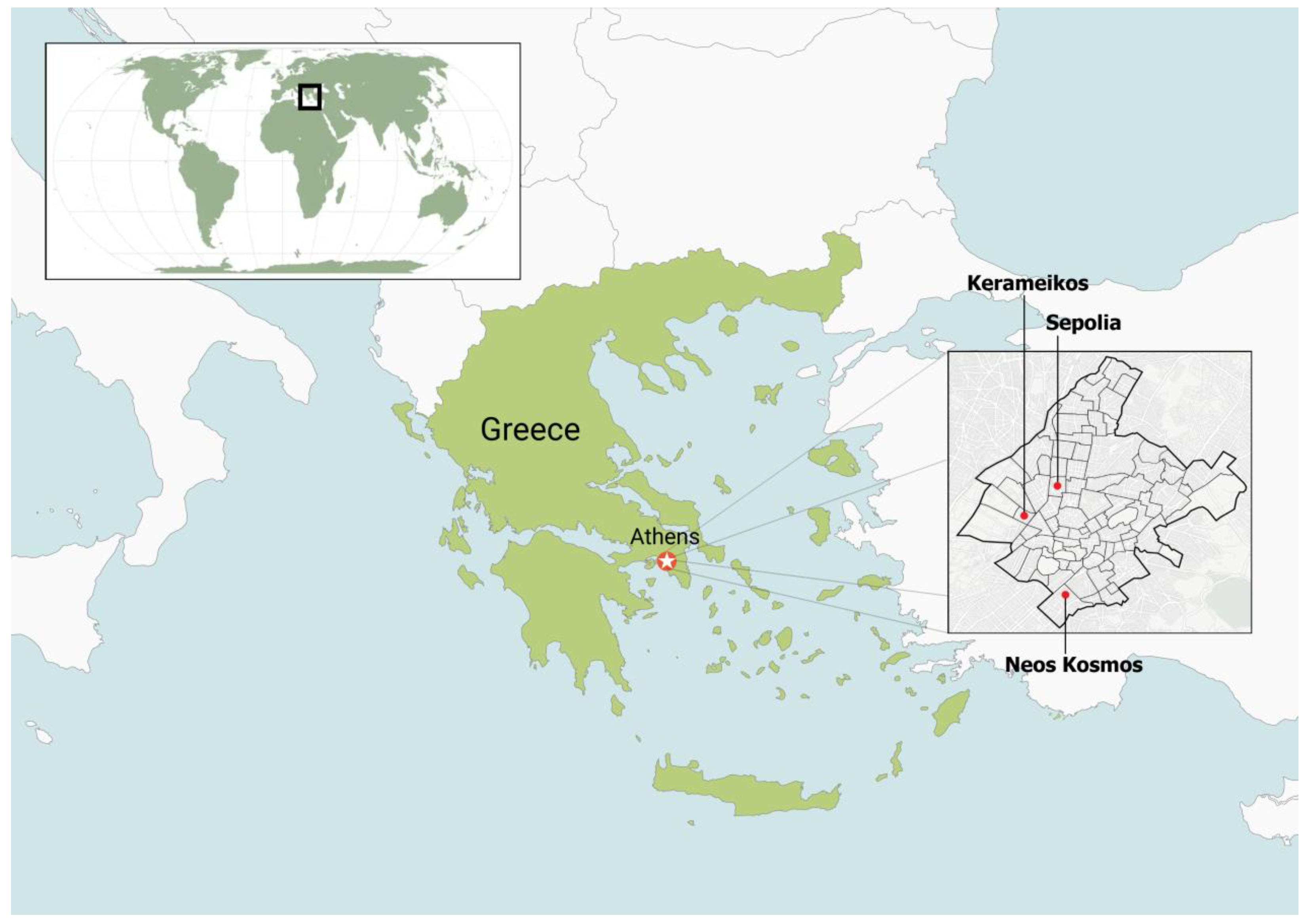
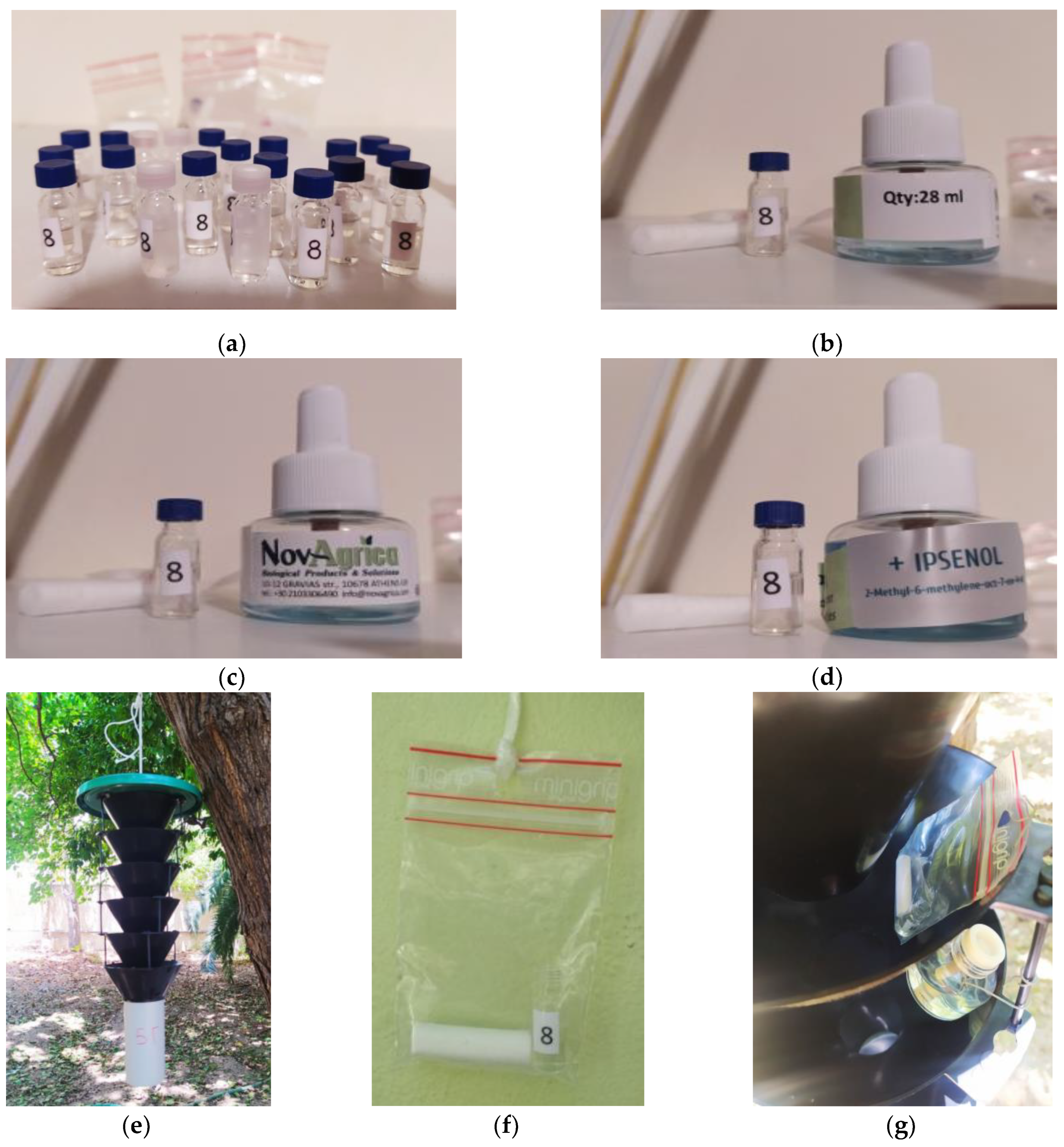
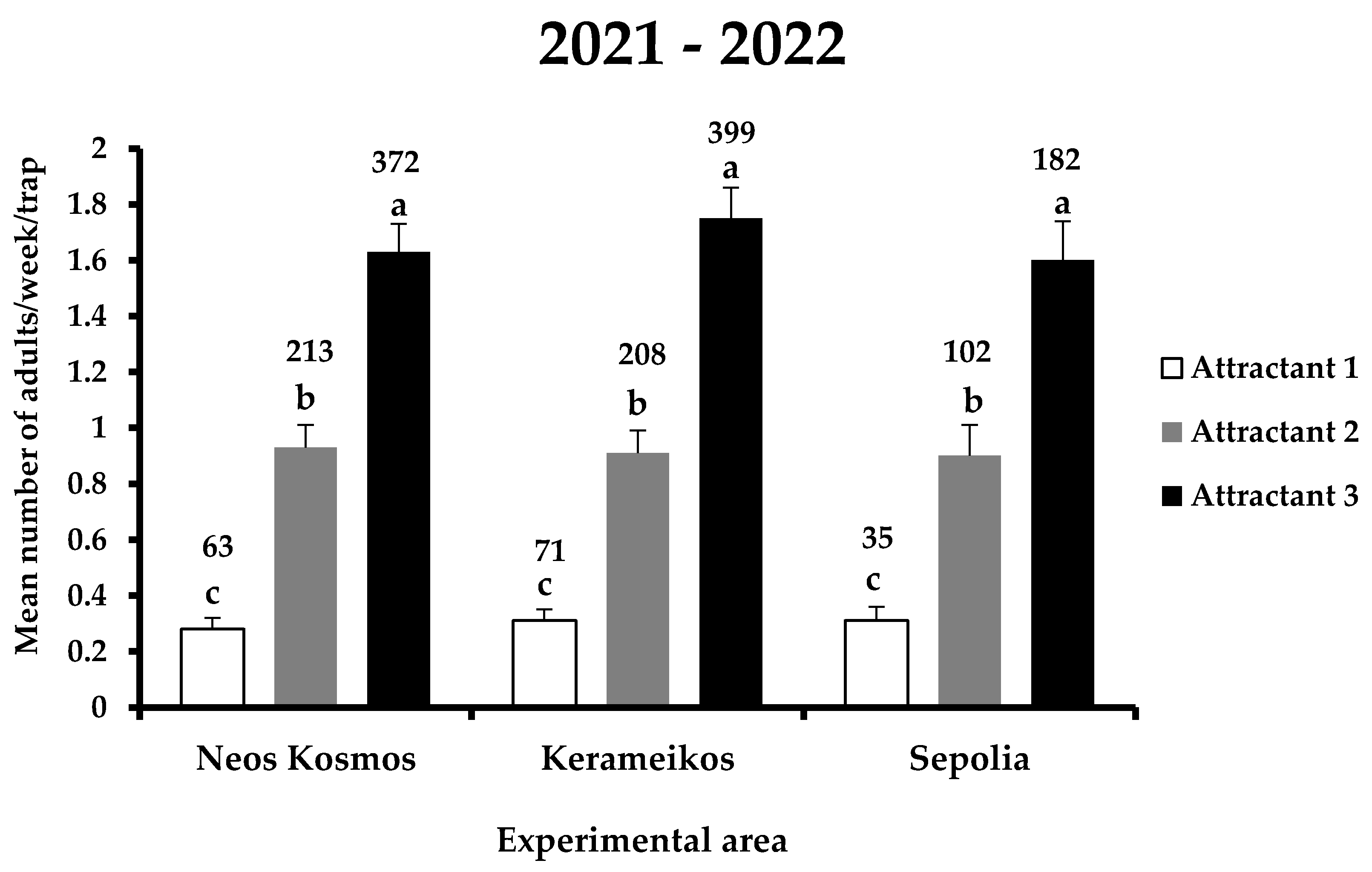
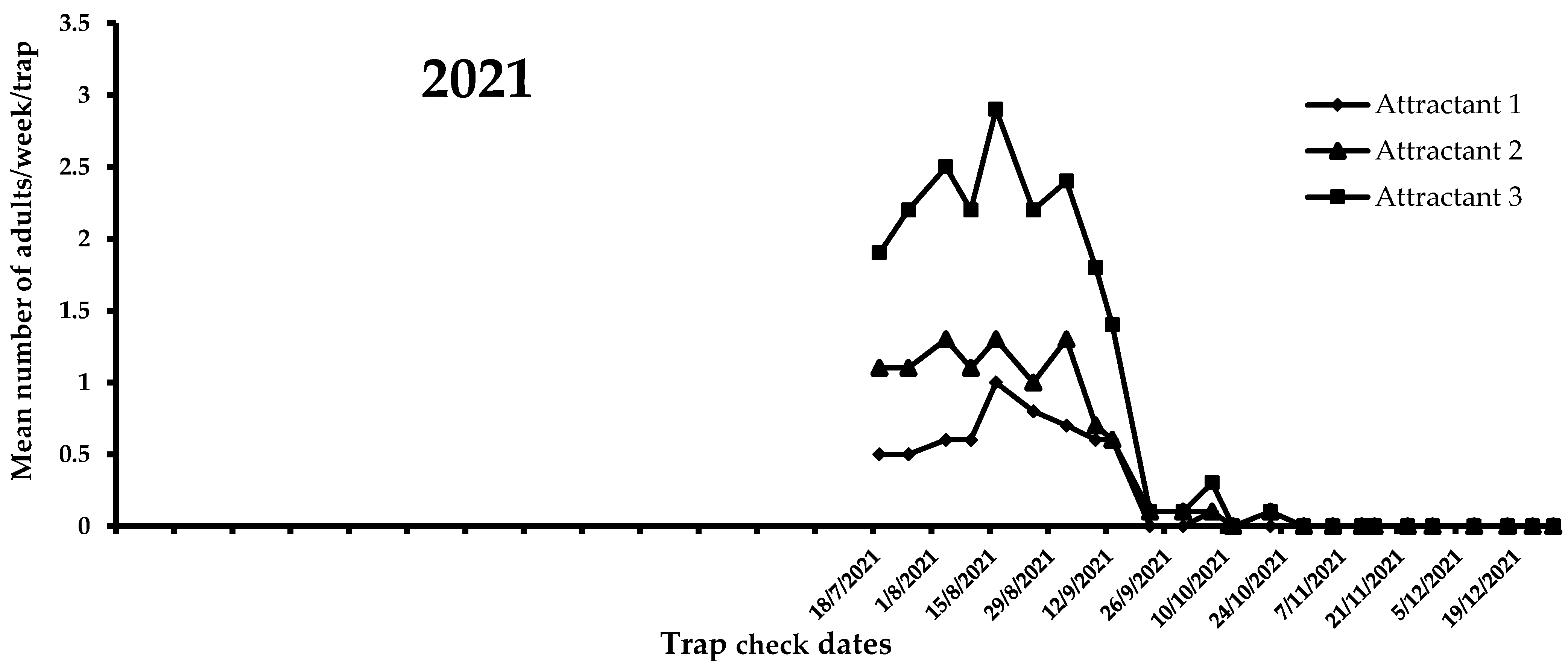
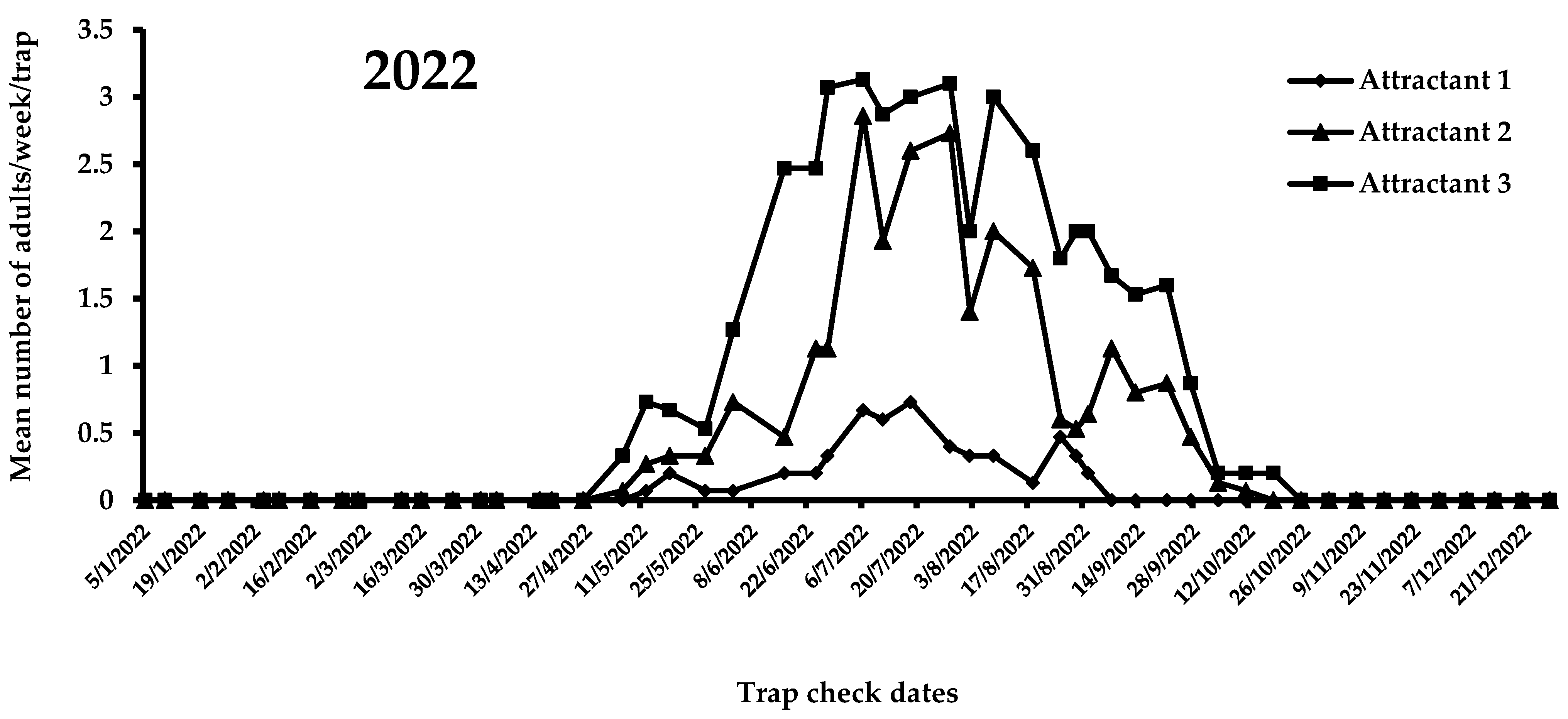
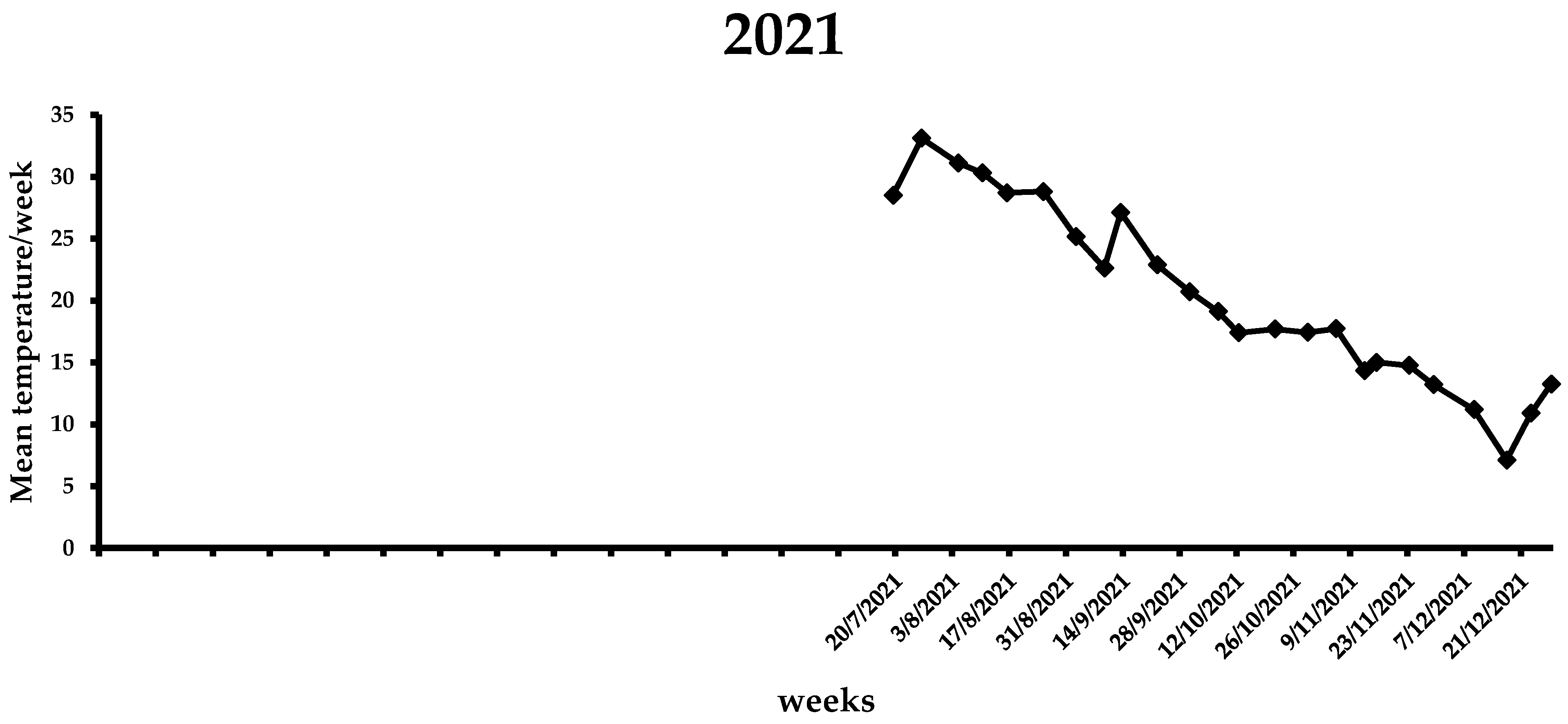
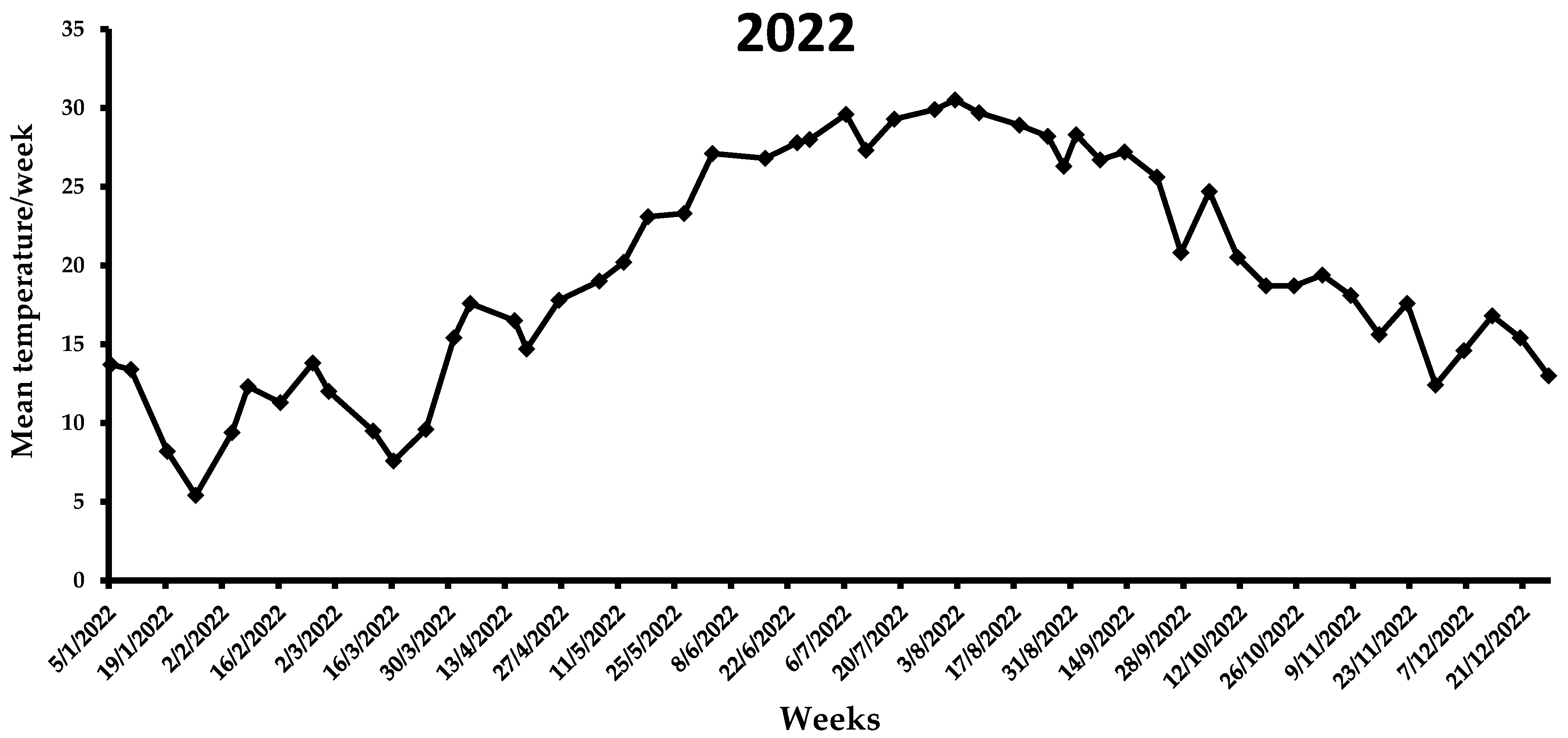
| Source | DF | F | p |
|---|---|---|---|
| Area | 2 | 0.2 | 0.84 |
| Attractant | 2 | 294.2 | <0.01 |
| Date | 37 | 20.6 | <0.01 |
| Area × attractant | 4 | 0.4 | 0.83 |
| Area × date | 74 | 1.6 | 0.01 |
| Attractant × date | 74 | 3.3 | <0.01 |
| Area × attractant × date | 148 | 1.0 | 0.54 |
Disclaimer/Publisher’s Note: The statements, opinions and data contained in all publications are solely those of the individual author(s) and contributor(s) and not of MDPI and/or the editor(s). MDPI and/or the editor(s) disclaim responsibility for any injury to people or property resulting from any ideas, methods, instructions or products referred to in the content. |
© 2023 by the authors. Licensee MDPI, Basel, Switzerland. This article is an open access article distributed under the terms and conditions of the Creative Commons Attribution (CC BY) license (https://creativecommons.org/licenses/by/4.0/).
Share and Cite
Kavallieratos, N.G.; Boukouvala, M.C.; Skourti, A.; Antonatos, S.; Petrakis, P.V.; Papachristos, D.P.; Papadoulis, G.T. Comparison of Three Attractants for the Effective Capture of Xylotrechus chinensis Adults in Multi-Funnel Traps. Insects 2023, 14, 676. https://doi.org/10.3390/insects14080676
Kavallieratos NG, Boukouvala MC, Skourti A, Antonatos S, Petrakis PV, Papachristos DP, Papadoulis GT. Comparison of Three Attractants for the Effective Capture of Xylotrechus chinensis Adults in Multi-Funnel Traps. Insects. 2023; 14(8):676. https://doi.org/10.3390/insects14080676
Chicago/Turabian StyleKavallieratos, Nickolas G., Maria C. Boukouvala, Anna Skourti, Spyridon Antonatos, Panos V. Petrakis, Dimitrios P. Papachristos, and Georgios Th. Papadoulis. 2023. "Comparison of Three Attractants for the Effective Capture of Xylotrechus chinensis Adults in Multi-Funnel Traps" Insects 14, no. 8: 676. https://doi.org/10.3390/insects14080676
APA StyleKavallieratos, N. G., Boukouvala, M. C., Skourti, A., Antonatos, S., Petrakis, P. V., Papachristos, D. P., & Papadoulis, G. T. (2023). Comparison of Three Attractants for the Effective Capture of Xylotrechus chinensis Adults in Multi-Funnel Traps. Insects, 14(8), 676. https://doi.org/10.3390/insects14080676










